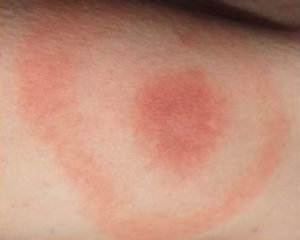By: Emma Applegate (Reposted by permission from the GB4000 Users Facebook Group )

Typical Lyme Bulls-eye Pattern
STRATEGIES ARE INDIVIDUAL When I started using my GB-4000/MOPA for Lyme and its co-infections, I started with the pathogen that was most the problematic for me, which was Babesia. So if you want, you can enumerate, from worst to least, the order in which you want to tackle these pathogens. Some people say to always start with Borrelia because this is what caused the immune system to derail in the first place. But in my case, I was really suffering fromBabesia, so this was what I tackled first.
I decided to use individual frequencies for:
- Babesia (see below for individual channels),
- Bartonella (see below for individual channels), and
- Borrelia (see below for individual channels).
With the other co-infections, I used the pre-programmed auto-channels or created my own.
LOW AND SLOW Whichever strategy you decide to use in your experiments, always start low and slow; meaning start at one minute with one frequency, or one minute with an auto-channel of many frequencies, or a single minute in your own custom channel.
Wait a couple of days to see how you react. If you experience a Herx reaction from the microbial die-off, then detox really well before you Rife again. Only Rife again once your Herxes have become manageable or have completely gone away.
So in effect, your herxes will determine how many times a week you will Rife, but try to get in three times a week if you can. In this way, you’ll make headway against the pathogen load. If you wait too long in between Rifing sessions, it’s harder to make an impact on decreasing pathogen load.
SCALING THE HERX In terms of scaling, you want to scale in small increments, again depending on the quality of your previous Herxheimer reaction. So if you herxed badly, you might just want to stay at the current time. If your previous herx was mild-moderate, then you have a choice of scaling 1-3 minutes, or possibly even 5 minutes.
THE LONGTERM TARGET The target goal for Rifing any individual frequency, or groups of frequencies, is at least 20 minutes. The 20 minute time has been proven to be most effective in terms of deep penetration of frequencies into the body to get to sequestered pathogens (those lurking in the deep tissues and nooks & crannies of the body).
ADDING MORE TARGETS TO THE MIX Before adding another pathogen to the mix, I always wait until my herxes from the current target pathogen have somewhat stabilized, i.e., mild enough to handle. The thing you don’t want to do is overburden your body with too much die-off, because then your detox organs will be overburdened. You need to especially protect the delicate nephrons of your kidneys. With the added pathogen, you scale up the same way as you did the previous one. So this is how you scale up.
As I’ve mentioned, you have a choice of using individual frequencies — one to three or more per pathogen — or you can use the pre-programmed auto-channels.
SWEEPS AND HARMONICS When you stop herxing, at some point in your Rifing journey, from the base frequencies, you might want to consider doing sweeps and harmonics, but that is a subject for another lecture.
USING THE SR-4 AMPLIFIER With the SR-4 Amp, you need to use both the footplates and the hand-helds.
I hope this method will help you to get started. Happy Rifing!
Individual Frequencies to try: Borrelia: 432, 2016, 612, 410, 788; later on, sweep 25400-29400, which is included in AC#466 Bartonella: 832, 357, 654, 842, 476.3, 655, sweep 1218-1230 Babesia: 570, 1584, 5775, 787, 526
You can also use the auto-channels in the book: Bartonella is auto-channel #125 (Cat virus), Lyme is found in auto-channels #466, 467, and 468. Unfortunately, Babesia doesn’t have an auto-channel, but you can look in the back of the New Universal Sideband Frequency List book under Babesiosis.
And you can always use Consolidated Anecdotal Frequency List (CAFL) as a reference for further frequencies that you can experiment with. http://www.electroherbalism.com/…/Frequenciesa…/CAFL.htm
Emma Applegate has been battling Lyme disease since November, 2007, and is winning the war with the aid of her GB4000/MOPA. She is a moderator of the Rifing Lyme Facebook Group
[Note: We are not medical doctors. We do not diagnose medical illnesses or prescribe any medical treatment. Please consult your doctor before starting any course of therapy.]
